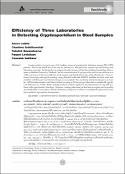บทคัดย่อ
Cryptosporium parvum เป็นเชื้อฉวยโอกาสที่พบในผู้ป่วยโรคติดเชื้อเอชไอวีระยะเอดส์ เนื่องจากโอโอศิย์สของเชื้อมีขนาดเล็ก การตรวจวินิจฉัยเชื้อนี้จึงต้องใช้วิธีย้อมสีพิเศษในห้องปฏิบัติการที่มีความชำนาญในการตรวจ การศึกษานี้เพื่อเปรียบเทียบความสามารถในการตรวจวินิจฉัยเชื้อ C. parvum ของ 3 หน่วยงานหลักในมหาวิทยาลัยมหิดล ผู้วิจัยเตรียมตัวอย่างอุจจาระจำนวน 30 ตัวอย่าง ในแต่ละตัวอย่างมีอุจจาระ 10 ไมโครลิตร มีโอโอศิย์สในความเข้มข้นต่างๆกัน ตั้งแต่ 6-1500 ตัว และมีอุจจาระ 3 ตัวอย่างที่ไม่ได้ใส่เชื้อลงไปเป็นกลุ่มควบคุม แล้วจัดส่งไปยังห้องปฏิบัติการทั้ง 3 แห่ง เพื่อทำการตรวจย้อมวิธีย้อมพิเศษ dimethyl sulfoxide (DMSO) หรือ modified acid-fast stain (kinyoun’s) ตามความชำนาญของแต่ละหน่วยงาน ผลปรากฏว่าเมื่อตรวจดูภายใต้กล้องจุลทรรศน์ การย้อมสีพิเศษทั้ง 2 วิธีมีความไวเหมือนกัน โดยห้องปฏิบัติการทั้ง 3 แห่ง สามารถตรวจวินิจฉัยโอโอศิย์สที่มีจำนวนน้อยกว่า 20 ตัว ในตัวอย่างอุจจาระ 10 ไมโครลิตรได้ไม่แตกต่างกัน (ค่าพี = 0.998) การใช้วิธีย้อมสีพิเศษ DMSO modified acid-fast stain (kinyoun’s) ได้ผลทั้ง 2 วิธี จึงสรุปว่าการใช้วิธีใดขึ้นอยู่กับความถนัดและการฝึกฝนอย่างถูกต้องของบุคลากรห้องปฏิบัติการ จะช่วยแพทย์ในการตรวจวินิจฉัยและการรักษาผู้ป่วยอย่างถูกต้องได้
บทคัดย่อ
Cryptosporidium parvum is one of the leading causes of opportunistic infections among HIV/AIDS
patients. Due to the small size of its oocysts, detection of this protozoan requires special staining and
laboratory expertise. In this study, we compare the effectiveness of the three leading parasitology laboratories
in Mahidol University, Thailand. Serial concentrations of Cryptosporidium parvum oocysts from 6 to
1,500 oocysts per 10 μl were added to stool samples and distributed to the study laboratories. Conventional
microscopy and special staining, using dimethyl sulfoxide (DMSO) modified acid-fast stain and
modified cold Kinyoun’s acid-fast techniques were applied. The sensitivity of both techniques was similar.
All three laboratories could detect at least as many as 20 oocysts per 10μl with no statistically significant
difference (p= 0.998). Either staining method could be applied at any laboratories serving HIV patients
with opportunistic infections. However, training laboratory technicians to acquire such expertise
and standardize it is necessary. Effective laboratory diagnosis would be very helpful for physicians, leading
to patients’ appropriate management.


